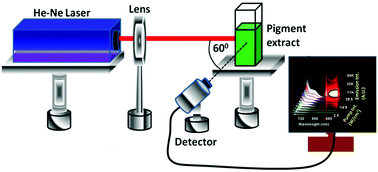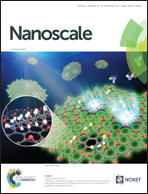Continuous wave random lasing in naturally occurring biocompatible pigments and reduction of lasing threshold using triangular silver nanostructures as scattering media†
Abstract
Random lasers have enormous applications in several fields including speckle-free imaging and bio-imaging. Thus, recently, random laser (RL) generation (mostly under pulsed operation) has been demonstrated in several commercial organic dyes with high photoluminescence quantum yields (PLQY). Although some commercial organic dyes have high PLQYs, these have several limitations; particularly, these dyes are not bio-compatible and thus cannot be used in in vivo bio-imaging. In this study, rarely reported bio-inspired continuous-wave (CW) RL generation has been demonstrated at ca. 674 nm, pumped by a low power He–Ne laser, in naturally occurring pigments of Hibiscus rosa-sinensis leaves extract (HRLe). The lasing threshold was reduced by ∼2.4 times from 40.7 W cm−2 (without scatterer) to 16.8 W cm−2 using anisotropic triangular nanostructures of silver (TNS) as a scatterer with a typical number density of 8 × 1015 nos. per ml. Unprecedentedly, further RL generation at ca. 691.7 nm with spectrally narrowed emission modes with a line-width of ca. 1 nm along with a very low lasing threshold of 15 W cm−2 has been demonstrated in a thin film of polyvinyl alcohol doped with methylene blue dye and TNS. This study will initiate a new era of development of bio-inspired RL for bio-photonics applications.



 Please wait while we load your content...
Please wait while we load your content...